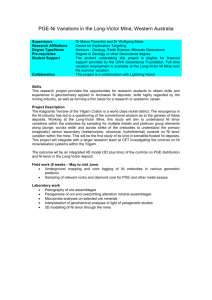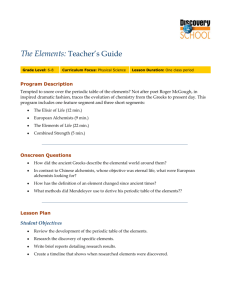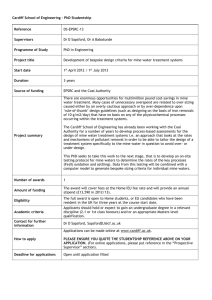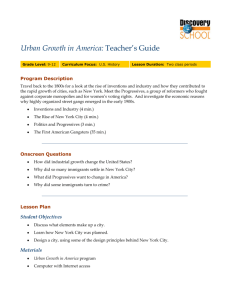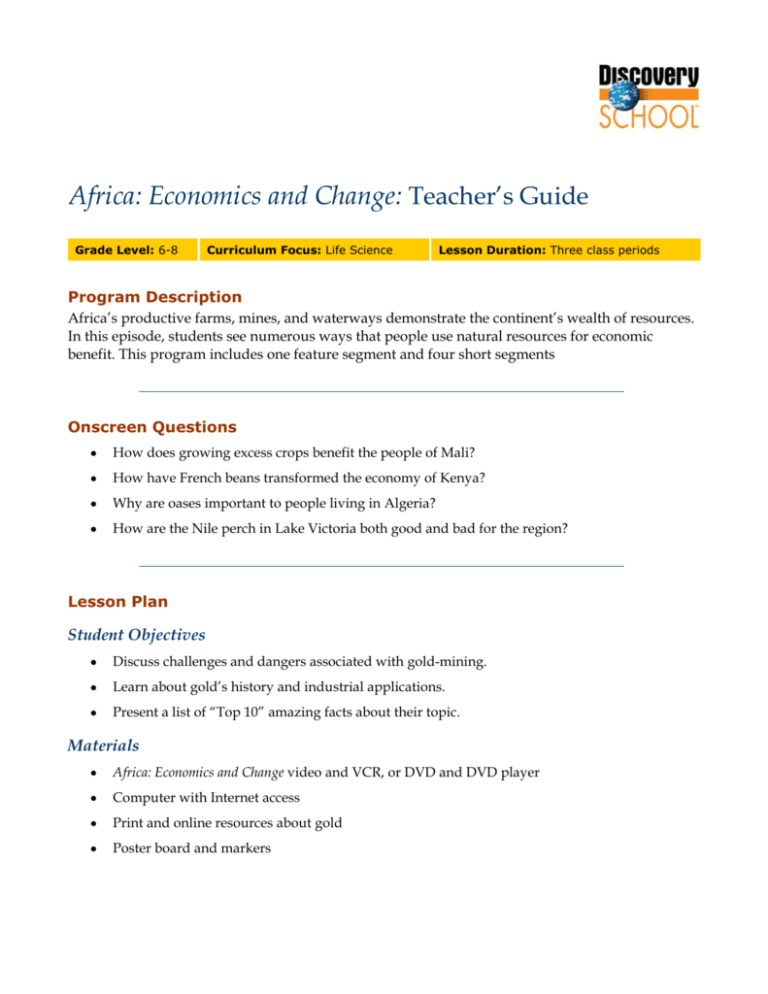
Africa: Economics and Change: Teacher’s Guide
Grade Level: 6-8
Curriculum Focus: Life Science
Lesson Duration: Three class periods
Program Description
Africa’s productive farms, mines, and waterways demonstrate the continent’s wealth of resources.
In this episode, students see numerous ways that people use natural resources for economic
benefit. This program includes one feature segment and four short segments
Onscreen Questions
•
How does growing excess crops benefit the people of Mali?
•
How have French beans transformed the economy of Kenya?
•
Why are oases important to people living in Algeria?
•
How are the Nile perch in Lake Victoria both good and bad for the region?
Lesson Plan
Student Objectives
•
Discuss challenges and dangers associated with gold-mining.
•
Learn about gold’s history and industrial applications.
•
Present a list of “Top 10” amazing facts about their topic.
Materials
•
Africa: Economics and Change video and VCR, or DVD and DVD player
•
Computer with Internet access
•
Print and online resources about gold
•
Poster board and markers
Africa: Economics and Change: Teacher’s Guide
2
Procedures
1. After watching the program, ask students to share what they learned about the gold-mining
industry. Where are the world’s deepest mines, such as Mponeng (the mine featured)? (South
Africa) Ask students to name challenges and dangers of working in a gold mine. Their answers
might include the following:
•
Cooling the air in the extreme underground heat
•
Penetrating tough rocks with drills and powerful explosives
•
Transporting and building supports to protect workers from the weight of the rock
•
Transporting men and materials down extremely deep mine shafts
•
Monitoring earthquakes
•
Explosions from methane gas trapped in small pockets of rock
•
Digging deeper and deeper mines to reach ore
•
Communicating with workers who speak many languages
•
Extracting gold from the ore
•
Working with toxic chemicals, such as cyanide
•
Completing the many steps of making gold bars out of gold ore
•
Transporting and protecting millions of dollars worth of gold
2. Ask students why they think gold is so expensive. (It is difficult and costly to mine and
produce; gold ore is rare and becoming harder to find.) Now brainstorm ways that gold has
been used throughout history. (Examples: jewelry, religious statues, building ornamentation)
3. Tell students that for thousands of years, gold has been one of society’s most precious resources.
For this lesson, they will work in groups to explore several facets of the mineral, from its history
to its industrial uses. They’ll research a topic and create a “Top 10” list of amazing facts to
present to the class.
4. Divide the class into six groups, assigning one of these topics to each group:
•
Gold production
•
Price of gold
•
History of gold
•
Industrial uses for gold
•
Gold jewelry
•
Properties of gold
Published by Discovery Education. © 2005. All rights reserved.
Africa: Economics and Change: Teacher’s Guide
3
5. Have students use print and online resources to research 15 to 20 facts about their topics.
(Encourage students to focus on the most important, interesting, or surprising facts.) The
following Web sites from the World Gold Council are a great place to start.
Gold Production
•
http://www.gold.org/value/markets/supply_demand/mine_production.html
•
http://www.gold.org/value/markets/supply_demand/recycled.html
Price of Gold
•
http://www.gold.org/value/stats/statistics/avprices1900.html
•
http://www.gold.org/value/stats/statistics/monthlysince1971.html
History of Gold
•
www.gold.org/discover/knowledge/aboutgold/gold_prod/index.html
•
www.gold.org/discover/knowledge/aboutgold/ancient_world/index.html
Industrial Uses of Gold
•
http://www.gold.org/discover/sci_indu/indust_app/index.html
•
http://www.gold.org/discover/knowledge/aboutgold/industrial_uses/index.html
Gold Jewelry
•
http://www.gold.org/discover/knowledge/aboutgold/gold_jewellery/index.html
•
http://www.gold.org/jewellery/goldandyou/karatage/index.html
•
http://www.gold.org/jewellery/technology/colours/index.html
•
http://www.gold.org/jewellery/technology/alloys/index.html
Properties of Gold
•
http://www.gold.org/discover/sci_indu/properties/index.html
6. Once students have collected facts, have them select the 10 most interesting, important, or
surprising facts. Have them create a “Top 10” poster, including at least one image, chart, or
graph.
7. Have teams present their posters and facts to the class. You can also challenge the class to create
a general “Top 10” list about gold or to develop a game that recalls the most amazing facts they
learned.
Assessment
Use the following three-point rubric to evaluate students’ work during this lesson.
•
3 points: Students were active in class discussion; named several challenges and dangers of
the mining industry; showed thorough research on their topic; created a clear,
comprehensive “Top 10” list that included 10 appropriate facts and more than one image,
chart, or graph.
Published by Discovery Education. © 2005. All rights reserved.
Africa: Economics and Change: Teacher’s Guide
•
2 points: Students participated in class discussions; named some challenges and dangers of
the mining industry; showed satisfactory research on their topic; created an adequate “Top
10” list that included 10 appropriate facts and one image, chart, or graph.
•
1 point: Students participated minimally in class discussions; did not name any challenges
and dangers of the mining industry; showed unsatisfactory research on their topic; created
an incomplete “Top 10” list that included fewer than 10 appropriate facts and no images,
charts, or graphs.
4
Vocabulary
Fangalo
Definition: A unique language spoken only in South Africa’s gold mines
Context: Miners in South Africa speak many different languages, but Fangalo allows them to
communicate in the mines
ore
Definition: A mineral from which a particular metal, such as gold, can be extracted
Context: Deeper mines are dug to reach new sources of gold ore.
reef
Definition: A vein or narrow band of gold ore; a strip or ridge of rocks, sand, or coral that rises to
or near the surface of a body of water
Context: Over millions of years the seabed’s rocks formed a reef.
shaft
Definition: A vertical passage in which an elevator travels
Context: The central shaft at Mponeng plunges more than two miles deep.
Academic Standards
Mid-continent Research for Education and Learning (McREL)
McREL’s Content Knowledge: A Compendium of Standards and Benchmarks for K-12 Education
addresses 14 content areas. To view the standards and benchmarks, visit http://www.mcrel.org/.
This lesson plan addresses the following national standards:
•
Geography—Environment and Society: Understands how human actions modify the
physical environment, Understands the changes that occur in the meaning, use, distribution
and importance of resources
•
Language Arts—Viewing: Uses viewing skills and strategies to understand and interpret
visual media; Reading: Uses reading skills and strategies to understand and interpret a
variety of informational texts
Published by Discovery Education. © 2005. All rights reserved.
Africa: Economics and Change: Teacher’s Guide
5
The National Council for the Social Studies (NCSS)
NCSS has developed national guidelines for teaching social studies. To become a member of NCSS,
or to view the standards online, go to http://www.socialstudies.org
This lesson plan addresses the following thematic standards:
•
People, Places, and Environments
•
Production, Distribution, and Consumption
Support Materials
Develop custom worksheets, educational puzzles, online quizzes, and more with the free teaching tools
offered on the Discoveryschool.com Web site. Create and print support materials, or save them to a
Custom Classroom account for future use. To learn more, visit
•
http://school.discovery.com/teachingtools/teachingtools.html
DVD Content
This program is available in an interactive DVD format. The following information and activities are
specific to the DVD version.
How To Use the DVD
The DVD starting screen has the following options:
Play Video—This plays the video from start to finish. There are no programmed stops, except by
using a remote control. With a computer, depending on the particular software player, a pause
button is included with the other video controls.
Video Index—Here the video is divided into four parts (see below), indicated by video thumbnail
icons. Watching all parts in sequence is similar to watching the video from start to finish. Brief
descriptions and total running times are noted for each part. To play a particular segment, press
Enter on the remote for TV playback; on a computer, click once to highlight a thumbnail and read
the accompanying text description and click again to start the video.
Curriculum Units—These are specially edited video segments pulled from different sections of the
video (see below). These nonlinear segments align with key ideas in the unit of instruction. They
include onscreen pre- and post-viewing questions, reproduced below in this Teacher’s Guide. Total
running times for these segments are noted. To play a particular segment, press Enter on the TV
remote or click once on the Curriculum Unit title on a computer.
Standards Link—Selecting this option displays a single screen that lists the national academic
standards the video addresses.
Teacher Resources—This screen gives the technical support number and Web site address.
Published by Discovery Education. © 2005. All rights reserved.
Africa: Economics and Change: Teacher’s Guide
6
Video Index
I. Africa’s Grain Basket (3 min.)
Although most of Mali is dry and barren, the southern part of the country is well suited to farming.
See why it’s called Africa’s grain basket.
II. A Beneficial Bean (3 min.)
French beans are a billion dollar industry in Kenya, where nearly 70 percent of the population
farms. Learn the history of Kenya’s beneficial bean.
III. World’s Deepest Goldmine (37 min.)
Travel to South Africa to tour the world’s deepest goldmine. Then, see how the ore is transformed
into gold bars.
IV. Fruits of the Desert (2 min.)
Algeria, best known for its vast and unrelenting desert, is a leading producer of dates. Discover
how Algerians create garden oases in the desert.
Curriculum Units
1. Farming in Mali
Pre-viewing question
Q: What do you need to grow crops?
A: Sunlight and water are necessary to grow most plants. In order to grow crops, you also need
good, mineral-rich soil.
Post-viewing question
Q: What crops are grown in Mali?
A: Rice, wheat, corn, and millet are widely grown in the southern part of Mali. Cotton, peanuts, and
other crops are also grown, but these crops are usually planted only when there has been a good
rainy season.
2. A Billion Dollar Business
Pre-viewing question
Q: What is a cash crop?
A: A crop that is grown only for sale; cash crops are not grown to feed a farmer’s family but purely
for the profit they will bring.
Post-viewing question
Q: What are some things that can damage bean crops?
A: Drought and flooding during the rainy season can ruin a bean crop. Other crop threats include
water pollution from fertilizer and pesticide runoff, soil erosion from planting too often, and
desertification.
Published by Discovery Education. © 2005. All rights reserved.
Africa: Economics and Change: Teacher’s Guide
7
3. Going Underground
Pre-viewing question
Q: Are the risks of mining gold worth the rewards?
A: Answers will vary.
Post-viewing question
Q: How are the explosives used in the gold mine safer than other explosives?
A: The explosives used in the gold mine contain two inert elements. Only when these elements are
mixed together do they chemically react to make a live explosive. The two are kept apart until the
last possible second, thereby keeping the miners as safe as possible.
4. Digging for Ore
Pre-viewing question
Q: Would you work in a gold mine?
A: Answers will vary.
Post-viewing question
Q: Do you think digging should continue at the Mponeng mine?
A: Answers will vary.
5. Burrowing Deeper
Pre-viewing question
Q: What are the risks of working in a mine?
A: Answers will vary.
Post-viewing question
Q: Why are supports necessary in a mine?
A: The supports prop up the cramped areas where the gold ore is mined. The weight of the mine is
constantly bearing down on these areas, without the supports the mine would collapse and the rock
above would come crashing in.
6. Seismic Activity and Methane
Pre-viewing question
Q: What would you do if you were in a mine when an earthquake occurred?
A: Answers will vary.
Post-viewing question
Q: Why is methane so dangerous in a mine?
A: Methane can be trapped in pockets in the rocks. Drilling sometimes accidentally releases this
gas. Just one spark from the machinery can set off a horrible methane explosion, killing or injuring
miners.
7. Creating Fresh Air
Pre-viewing question
Q: Do you function better in hot or cold climates?
A: Answers will vary.
Published by Discovery Education. © 2005. All rights reserved.
Africa: Economics and Change: Teacher’s Guide
8
Post-viewing question
Q: Why is air conditioning necessary in the mine?
A: The deeper in the mine, the hotter the air is. Temperatures can exceed 122 degrees Fahrenheit. It
would be impossible to work in such conditions without air conditioning.
8. From Ore to Liquid Gold
Pre-viewing question
Q: Is it expensive to produce gold from ore?
A: Yes. To extract a single ounce of gold costs hundreds of dollars.
Post-viewing question
Q: Why is the mud and wastewater from gold processing collected?
A: It’s collected because gold ore has dissolved in it. The mud containing the gold ore is pumped
into a mud press, where the water is squeezed out.
9. Taking Safety Precautions
Pre-viewing question
Q: What problems can result from poor communication?
A: Answers will vary.
Post-viewing question
Q: Why was a special language developed for use in the mine?
A: Workers in the mine come from many places and speak several different languages. This spells
danger in an environment where clear communication is a necessity. So, the workers have come up
with their own language, using pieces of all the languages spoken in the mine. Though it is very
basic, it allows communication among all the workers.
10. A Never-Ending Process
Pre-viewing question
Q: What do you think is the most important job in a mine?
A: Answers will vary.
Post-viewing question
Q: What would happen if Mponeng stopped operating?
A: Answers will vary.
11. Creating a Desert Oasis
Pre-viewing question
Q: What are some ways we capture water for human use?
A: Answers will vary.
Post-viewing question
Q: How does the Algerian method of collecting water work?
A: Algerians use an age-old method for moving water from one place to another. The method
essentially creates holes that bring water from underground reservoirs to the surface. First, they
push a long plate through the ground until it hits an underground reservoir. The water bubbles to
Published by Discovery Education. © 2005. All rights reserved.
Africa: Economics and Change: Teacher’s Guide
9
the surface, where it runs into gardens through channels. The water passes from one hole to
another, and small storage wells keep it fresh and cool.
12. Nile Perch Fishing
Pre-viewing question
Q: What non-native plants and animals live in your area?
A: Answers will vary.
Post-viewing question
Q: What problems are caused by Nile perch living in Lake Victoria?
A: The Nile perch is not native to Lake Victoria. Hundreds of native species in the lake have been
killed off because of the perch. The perch, themselves, are getting smaller because they are running
out of food. Also, as more fishing companies move to the area, they are removing the vegetation
from around the lake and destroying the environment.
Published by Discovery Education. © 2005. All rights reserved.



